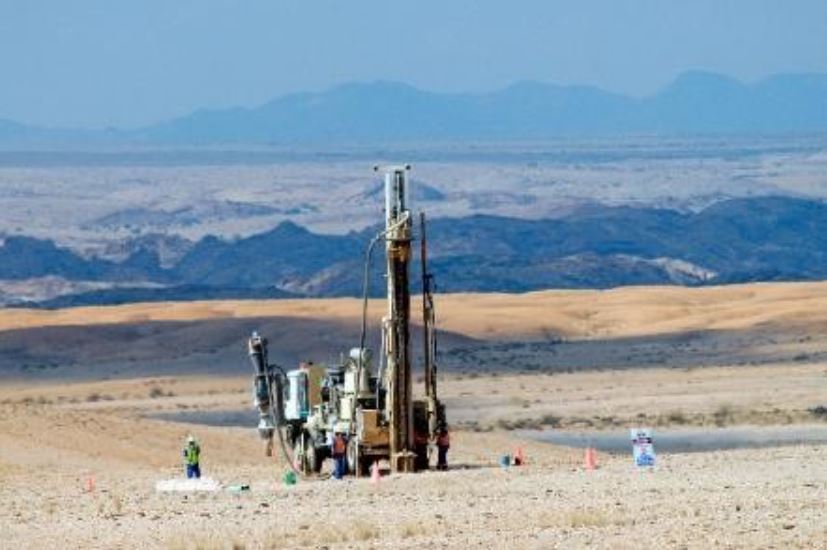Namibia Critical Metals advancing Lofdal rare earths project

Namibia Critical Metals Inc. [NMI-TSXV] has provided an update on progress at the Lofdal heavy rare earth project in northern Namibia, which is a joint venture with Japan Oil, Gas and Metals National Corp. (JOGMEC). The Lofdal joint venture is operating under a term 1 budget of $3-million, with the objectives of doubling the current resource size at Area 4 with a 7,700-metre drill program, testing two high-priority exploration targets with 1,500 metres of drilling, and carrying out further metallurgical testwork to optimize the processing flowsheet. Progress since stating the drill program in early March, 2020, is summarized as follows:
- Drilling ahead of schedule with over 50% completed at Area 4, with results from the first nine holes now reported;
- Drill results consistent with expected grades and thickness, as predicted from the resource model, targeting to double current resource size in this first drilling phase;
- Drill rig will now move to exploration targets at Northern Splay and Dolomite Hill;
- Metallurgical bulk test runs (2.7 tonnes) completed on X-ray transmission sorter, with analytical results pending. X-ray transmission sorter tests are under way, and the company is expecting to complete bulk test runs (4.4 tonnes) by mid-July.
Drill highlights of heavy-rare-earth-enriched zones include:
- 22 metres at 0.29% total rare earth oxides (TREO) with 67.7% heavy rare earth enrichment (including three metres at 0.87% TREO with 89% heavy rare earth enrichment);
- 15 metres at 0.32% TREO with 62.5% heavy rare earth enrichment (including three metres at 0.51% TREO with 79.3% heavy rare earth enrichment);
- Six metres at 0.33% TREO with 89% heavy rare earth enrichment (including 2 metres at 0.52% TREO with 93.1% heavy rare earth enrichment).
Don Burton, President of Namibia Critical Metals, stated: “All holes drilled to date have intersected the main zone, as expected. As we await lab results from the remaining 13 holes from this phase of the Area 4 drilling, it is an opportune time to move the drill to our exploration targets, where we believe the potential exists to develop satellite deposits. The drill will then return to Area 4 to complete the resource drilling program. The metallurgical program is advancing well, with both XRF and XRT sorting tests providing very encouraging results. The objective with sorting is to achieve a two-to-three-times upgrade to the deposit grade, and we look forward to a comprehensive evaluation of both technologies upon completion of the bulk test runs, which will use about seven tonnes of representative sample collected from trenches at Area 4.
“These are challenging times for field operations, and we are extremely fortunate to have a dedicated team in Namibia that has actually exceeded the planned monthly production since start-up in March. Field operations continue with strict COVID-19 protocols in place.”
The Lofdal heavy rare earth project is located 450 km northwest of the capital city of Windhoek in the Kunene region of northwestern Namibia. The project area covers 314 km2 centred on the Lofdal carbonatite complex, which hosts a number of rare earth occurrences, including the Area 4 deposit. Mineralization at Area 4 is dominated by xenotime, which is highly enriched in heavy rare earth. Value drivers at Lofdal are dysprosium and terbium.
The current mineral resource at Area 4 has been drilled to depths of between 125 to 225 vertical metres and is estimated to be 2.88 million tonnes Indicated grading 0.32% TREO, yielding 9,230 tonnes of REO, of which 7,050 tonnes are estimated to be heavy rare earth oxides (HREO), and 3.28 million tonnes Inferred grading 0.27% TREO yielding 8,970 tonnes of REO, of which 6,700 tonnes are estimated to be HREO.
Drilling will now move from Area 4 to test exploration targets at the Northern Splay and Dolomite Hill targets. Northern Splay is located 10 km northeast of Area 4 on an extension of the Area 4 structure, and Dolomite Hill is situated 2.5 km north of Area 4 in a separate mineralized structure.
The primary objective of the Lofdal joint venture is to double the current resource size with an additional 7,700 metres of drilling. The company has completed 4,447 metres of drilling to date in 21 holes at Area 4. Drilling operations have continued uninterrupted since beginning in early March, 2020, and remain on schedule; however, slight delays in receiving laboratory results have been realized due to COVID-19 restrictions in Namibia and Canada. These restrictions have since eased, and a steady flow of analytical results is now expected to resume.
Results from the first nine holes have been received, and all holes have intersected mineralization in the main zone consistent with expected grades and thicknesses, as predicted from the resource model.
Namibia Critical Metals is operator for the Lofdal joint venture.
